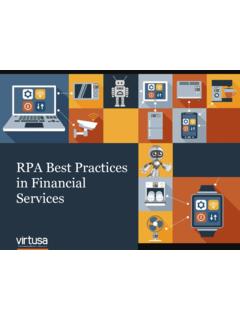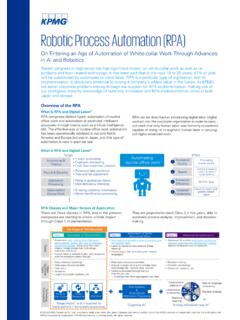Transcription of Calculate Client Security Hash - UiPath
1 process Design Document Calculate Client Security Hash process Design Document Calculate Client Security Hash 1 process Design Document History Date Version Role Name Organization Function Comments Draft Olfa Ben Taarit ACME Systems Inc. SME Creation v Reviewer Vrabie Stefan UiPath BA Approved v Reviewer Silviu Predan UiPath RPA Dev Updated process Design Document Calculate Client Security Hash 2 Table of Contents 1. Introduction .. 3 Purpose of the document .. 3 Objectives .. 3 process key 3 2. AS IS process 4 process overview .. 4 Detailed process map .. 6 Detailed process Steps .. 8 Exceptions handling .. 11 Error mapping and handling .. 12 In-Scope application details .. 12 3. Development details.
2 13 Prerequisites for development .. 13 Password policies .. 13 Credentials and asset management .. 13 4. Document Approval 13 5. Appendix .. 14 UiPath automated process details .. 14 process Design Document Calculate Client Security Hash 3 1. Introduction The process Design Document describes the business processes chosen for automation using the UiPath robotic process automation (RPA) technology. This document describes the sequence of steps performed as part of the process , as well as the conditions and requirements prior to its automation . This design document serves as a base documentation for developers to collect the details required for robotic automation of the same business process . The process has been selected for RPA as part of the larger project initiative conducted within ACME Systems Inc.
3 , the finance and Accounting department. The objective of this process automation is linked to the project business case and is mainly intended to: Deliver faster processing Reduce redundant activities Improve overall performance and reliability The Design Document includes a brief, but comprehensive set of requirements for the process . Its structure is based on the input provided by the Subject Matter Expert (SME) in the process . Role Name Date of action Notes process SME Aurel Vlaicu TBD Point of contact for questions related to business exceptions and passwords Reviewer / Owner Sergiu Celibidache TBD POC for process exceptions Approval for production Nicoale Herlea TBD Escalations, Delays process Design Document Calculate Client Security Hash 4 2. AS IS process Description General information about the process selected for RPA implementation, prior to its automation : AS IS process details process full name Calculate Client Security Hash Function Security Department finance and Accounting process short description (operation, activity, outcome) Generate the Security Hash for each Client based on their personal information.
4 Role required for performing the process System 1 User process schedule Daily # of item processes / day 7 15 Clients Average handling time per item 2 min / Client Peak period (s) No peak period # of FTEs supporting this activity 1 Level of exception rate No expected exceptions Input data Client Data Output data Client Security Hash process Design Document Calculate Client Security Hash 5 In scope for RPA The activities and exceptions in this process that are in the scope for RPA, are listed below: Full Scope for RPA - the process is to be 100% automated. Out of scope for RPA There are no activities out of scope for RPA process Design Document Calculate Client Security Hash 6 This chapter presents the chosen process in detail, which enables the developer to build the automated process .
5 Step Short Description Open the ACME System 1 Web Application. Log in to System 1. Required input data: email and password. Access the Dashboard - the central location, where the user can pick a specific menu item. Access the Work Items listing to view all the available tasks to be performed (Output data: Work Items). For each activity of the WI5 type, perform the following steps: Start Log in to ACME System 1 web application Access Work Items on the dashboard Select an activity of type WI5 Copy Client information from the details page Open SHA1 website and enter the correct formula Retrieve Client Security hash from the website Go back to Work Item and open Update Work Item page Set the status to Completed and the Security Hash as a comment End process Design Document Calculate Client Security Hash 7 Open the Details page of the selected activity to retrieve the Client Information Details.
6 Open the SHA1 Online webpage - , and provide the following input: [ClientID]-[ClientName]-[ClientCountry]. Replace all the variables with the corresponding values. Use dashes between items, as shown above. Retrieve the Client Security Hash value from the webpage. Go back to Work Item Details and open Update Work Item. Set the status to Completed . Add a comment with the obtained [SecurityHash]. Continue with the next WI5 Activity. process Design Document Calculate Client Security Hash 8 The complete set of steps in the process , including keystrokes and clicks, are to be defined with screenshots. If there are any data restrictions, mask the sensitive information, such as Policy Number, Customer ID, bank account number, etc). # Step action description Screenshot Expected result Remarks Open the ACME System 1 Web Application The display of the System 1 Web App screen.
7 Possible exception: - Handle exception if Web app not available Log in to System 1. Required input data: email and password. Access to the dashboard Possible exception: - Handle exception if Incorrect email or Password Access the Dashboard - the central location, where the user can pick a specific menu item The display of each item in the menu process Design Document Calculate Client Security Hash 9 Access the Work Items listing to view all the available tasks to be performed The display of the task list For each activity of the type WI5 perform the following steps: Possible exception: Handle exception if no task of type ' Calculate Client Security Hash exist Open the Details page of the selected activity to retrieve the Client Details (Output data: Client Details) Open the SHA1 Online Webpage - and provide the following input.
8 [ClientID]-[ClientName]-[ClientCountry] Replace all the variables with the corresponding values. Use dashes between items, as shown above. process Design Document Calculate Client Security Hash 10 Retrieve Client Security Hash from the webpage Go back to the Work Item Details and select Update Work Item Set the status to Completed . Add a Comment with the obtained [SecurityHash] Continue with the next WI5 Activity process Design Document Calculate Client Security Hash 11 The types of exceptions identifiable in the automation process can be classified according to the table below. Based on the above criteria, the table below should reflect all the known exceptions identified throughout the process and map the expected action the robot needs to take in each case.
9 Insert as many rows as required in the table, to capture all exceptions in a comprehensive list. For any other unanticipated or unknown exceptions, the robot should send an email notification at with the original email and error message screenshot attached. Area Known Unknown Business Previously encountered situation. A possible scenario is defined, and clear actions and workarounds are provided for each case. A situation never encountered before. It can be caused by external factors. # Exception name Step where exception is encountered Parameters Action to be taken 1 Incorrect email or password Step # If message for incorrect username or password exist Send email to Hello, The username or the email is incorrect. Please check and restart Thank you 2 No task of type WI5 exists Step # Stop process process Design Document Calculate Client Security Hash 12 A comprehensive list of all the errors, warnings, or notifications should be consolidated here with the description and action to be taken by the Robot in each case.
10 The errors identified in the automation process can be classified according to the table below. Based on the above criteria, the table below should reflect all the identifiable errors in the process , and map the expected action of the Robot in each case. Insert as many rows as required in the table, to capture all the errors in a comprehensive list. *Feel free to insert an additional error mapping table for more complete explanation. The table below lists all the applications that are used as part of the automated process . # Application name & Version Syst. Lang. Login module Interface Environment/ Access method Comments 1 ACME System 1 EN Web Web Web Browser 2 SHA1 Online EN n/a Web Web Browser Area Known Unknown Technology Previously encountered situation - action plan or workaround available. A situation never encountered before, or may happened independent of the applications used in the process .





